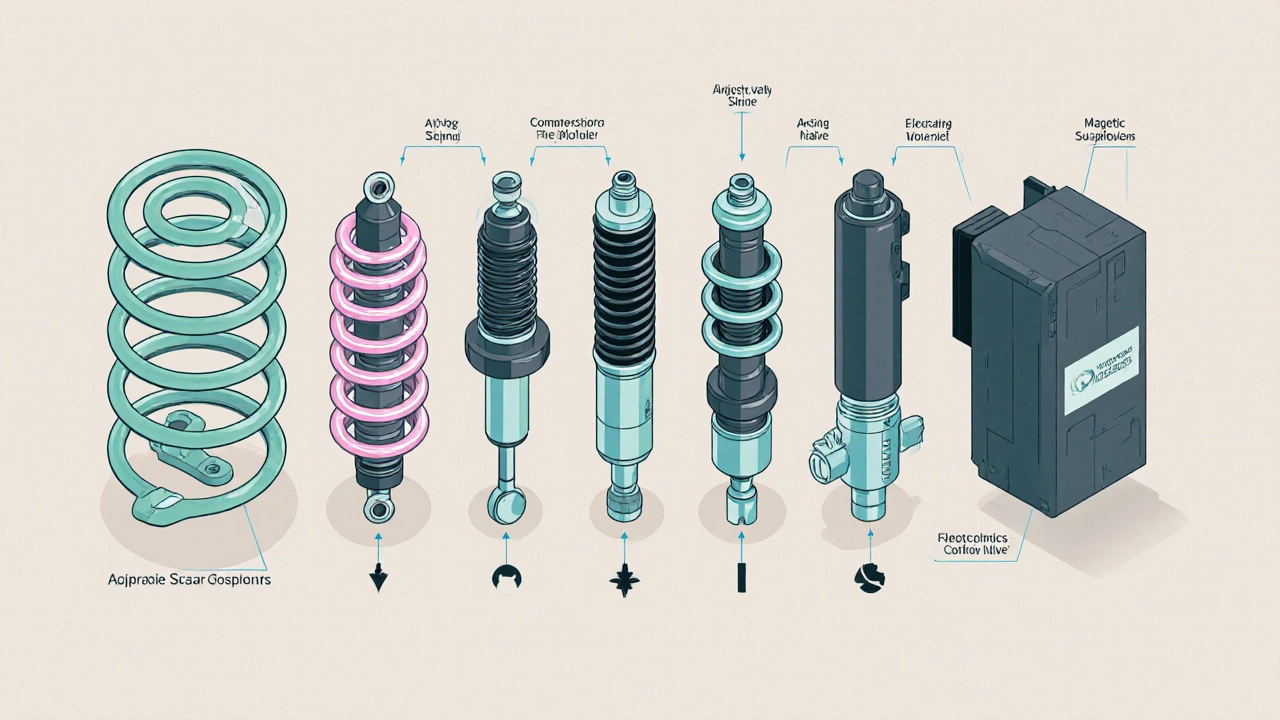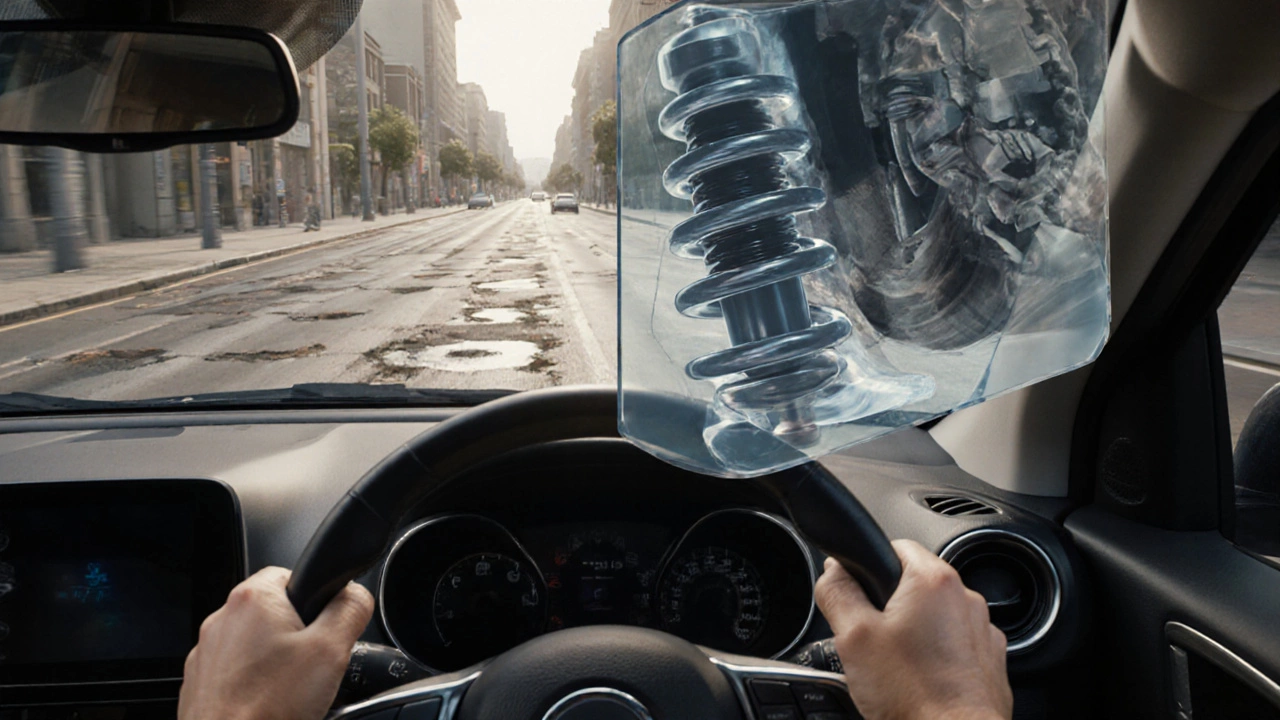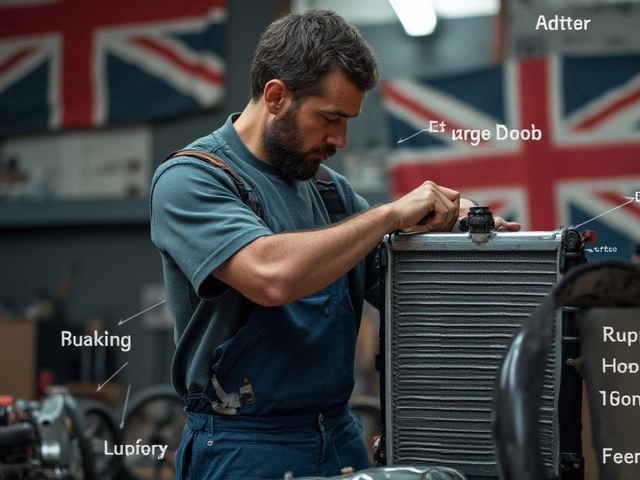Suspension System Selector
Choose Your Suspension Needs
Answer these quick questions to find the best suspension system for your vehicle.
Vehicle Purpose
Typical Load
Road Conditions
Budget Range
Driving on uneven streets can turn a routine commute into a jolt‑filled nightmare. The right suspension setup not only smooths out the ride but also protects your tires, steering, and chassis from premature wear. Below you’ll find a straight‑to‑the‑point rundown of which suspension systems excel on rough surfaces, how they differ, and what to look for when upgrading.
Key Takeaways
- Air suspension and adjustable coilovers provide the highest comfort on bumpy roads.
- Leaf springs are durable for heavy loads but feel stiff on uneven pavement.
- Modern shock absorbers and struts are essential for controlling bounce, regardless of spring type.
- Active and magnetic ride‑control systems deliver real‑time adaptation at a premium price.
- Consider vehicle weight, daily load, and budget before picking a system.
Understanding the Core of a Suspension System
Suspension system is a combination of springs, dampers, and linkages that connects a vehicle’s body to its wheels, absorbing shocks and maintaining tire contact with the road. Its primary job is twofold: keep the cabin comfortable and keep the tires glued to the surface for safe handling.
Spring Types - The Heart of Comfort
When the road throws bumps at you, the spring decides how much of that energy gets transferred to the cabin.
Coil spring is a metal helix that compresses under load and expands to push the wheel back into place. It’s the most common choice for passenger cars because it balances comfort and cost. A well‑tuned coil spring paired with quality dampers can handle moderate roughness without sacrificing handling.
Leaf spring is a stack of layered steel strips that flex as a single unit. Traditionally used on trucks and older cars, leaf springs excel at carrying heavy loads but often feel harsh on uneven pavement.
Air suspension is a system that replaces metal springs with rubber bags filled with compressed air, regulated by an on‑board compressor and electronic controller. It lets you raise or lower ride height and tune firmness on the fly, making it the best suspension for drivers who face constantly changing road conditions.
Adjustable coilover is a unit that combines a coil spring with a shock absorber, featuring threaded collars or spring‑rate selectors for fine‑tuning ride height and stiffness. It offers a middle ground between a fixed coil spring and a full air system.

Dampers - Controlling the Bounce
Springs alone would let the car bounce endlessly. Dampers (shock absorbers) convert kinetic energy into heat, slowing the motion.
Shock absorber is a hydraulic or gas‑filled cylinder that resists rapid suspension movement. Modern monotube designs provide consistent damping across temperature ranges.
Strut is a structural component that combines a shock absorber with a coil spring, also serving as a steering pivot in front‑end setups. Struts are common on many front suspensions and affect alignment.
High‑Tech Solutions - Real‑Time Adaptation
For drivers who demand premium comfort, active systems read road input and adjust damping instantly.
Magnetic ride control is a damping technology that uses magnetorheological fluid whose viscosity changes under an electromagnetic field, allowing milliseconds‑fast adjustments. It delivers a plush ride without sacrificing sporty handling, but the price tag reflects its complexity.
Active suspension is a system that employs sensors, actuators, and a control unit to modify spring and damper forces in real time. It can counteract bumps before they reach the cabin, yet it is typically reserved for luxury or performance vehicles.
Comparison of Popular Suspension Types for Rough Roads
| Type | Ride Comfort | Load Capacity | Adjustability | Typical Cost (USD) |
|---|---|---|---|---|
| Coil spring + standard shock | Good | Medium | Low | $300‑$600 per axle |
| Leaf spring + shock | Fair | High | Low | $250‑$500 per axle |
| Air suspension | Excellent | Medium‑High | High (height & firmness) | $1,200‑$2,500 per axle |
| Adjustable coilover | Very Good | Medium | High (height & spring rate) | $800‑$1,400 per axle |
| Magnetic ride control | Excellent | Medium | Very High (real‑time damping) | $2,000‑$3,500 per axle |
| Active suspension | Excellent | Medium | Very High (full system control) | $3,000‑$5,000 per axle |

Choosing the Right Setup - A Practical Checklist
- Know your vehicle’s purpose: Daily commuter, work truck, or weekend track car?
- Assess typical load: Heavy cargo needs higher load capacity (leaf springs shine).
- Consider road conditions: Frequent potholes or cobblestones favor air or adjustable coilovers.
- Set a budget ceiling: Air kits start around $1,200, while magnetic systems can exceed $3,000.
- Plan for installation: Air systems often need compressors and control modules; coilovers are more DIY‑friendly.
Installation Tips and Common Pitfalls
- Always replace shocks/struts when swapping spring types - mismatched damping leads to a harsh ride.
- For air suspension, ensure the compressor’s airflow rating matches the bag size; undersized compressors cause lag.
- When adjusting coilovers, make small increments (2‑3mm) and test‑drive after each change.
- Check alignment after any suspension overhaul; even tiny angle changes affect tire wear on rough roads.
- Beware of cheap aftermarket shocks that claim “premium” performance - they often lack proper valving for low‑speed bumps.
Real‑World Examples
John, a delivery driver in Manchester, swapped his van’s leaf springs for an air‑bag kit. He reported a 40% reduction in driver fatigue after a week of city traffic riddled with potholes.
Emma, an enthusiast who loves weekend drives on the Lake District’s winding roads, installed adjustable coilovers on her hatchback. The ability to raise the car for daily commuting and lower it for spirited drives gave her the best of both worlds without breaking the bank.
A boutique performance shop fitted a magnetic ride‑control system on a luxury sedan for a client who demanded a plush ride and razor‑sharp handling. The driver noted that the car “just glides over road imperfections” while still feeling planted in corners.

Maintenance Essentials
Regardless of the chosen system, regular checks keep the ride smooth.
- Inspect air bags for cracks or leakage every six months.
- Replace shock absorber oil seals if you hear squeaks or excessive bounce.
- Torque all mounting bolts to manufacturer specs after installation.
- Check for uneven tire wear monthly; it often hints at misaligned suspension components.
Bottom Line - Which Suspension Wins on Bumpy Roads?
If you want the most adaptable, comfortable ride and don’t mind the price, air suspension takes the crown. For drivers who prefer a DIY approach with a decent level of tweakability, adjustable coilovers are the next best choice. Leaf springs stay relevant only for heavy‑load applications where durability outweighs comfort.
Frequently Asked Questions
Can I install an air suspension kit on any car?
Most modern passenger cars can accommodate an air‑bag retrofit, but you’ll need compatible mounting points and a supporting chassis. Older models may require custom brackets or reinforcement, so check the kit’s vehicle compatibility list before buying.
Do coilovers hurt fuel economy?
Because coilovers are heavier than basic coil springs, they can add a few tenths of a liter per 100km to fuel consumption, especially if you run them at a very stiff setting. The impact is usually minor compared with the performance benefits.
How often should I replace shock absorbers on a bumpy road?
A good rule of thumb is every 60,000-80,000km for standard shocks. If you constantly drive on rough surfaces, inspect them every 10,000km and consider replacement at the 40,000km mark to maintain comfort.
Is magnetic ride control worth the extra cost?
If you demand a blend of sport‑car handling and limousine‑level smoothness, magnetic ride control delivers that uniquely. For everyday commuting on bumpy streets, an air suspension or quality coilover setup offers comparable comfort at a lower price.
Do leaf springs need special alignment?
Yes. Leaf springs affect the vehicle’s caster and camber angles. After swapping them, a professional alignment ensures the wheels sit correctly, preventing uneven tire wear.




